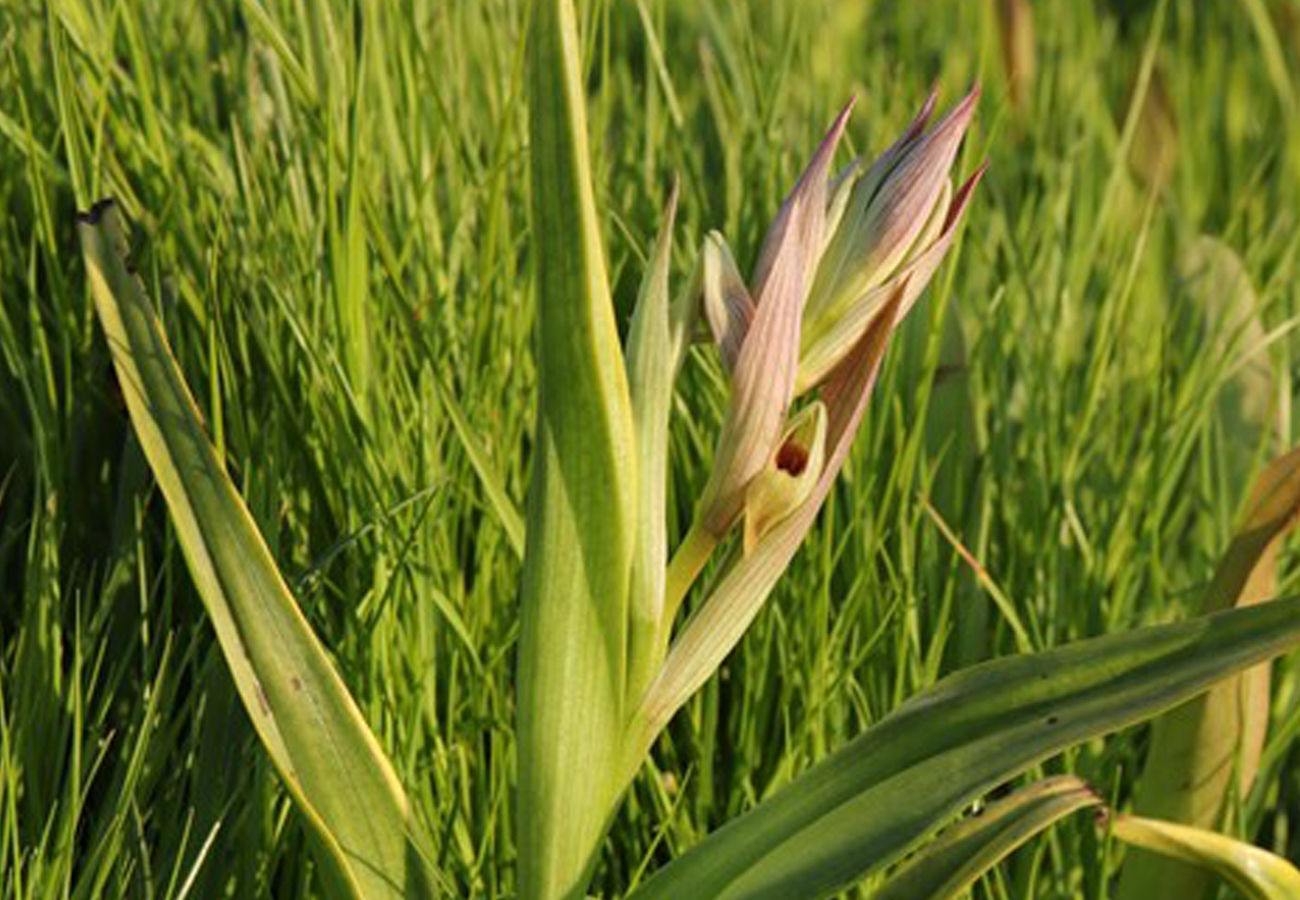Abstract
Serapias ausoniae, here described as a new species, is known only from the southern part of the Apulia, Italy. The new taxon is morphologically similar to S. parviflora but is larger than sympatric S. parviflora specimens. Serapias ausoniae is characterized by larger floral elements, in particular, the bract is longer (~ 5.0 cm) and wider (~ 1.5 cm) and the dimensions of epichile, hypochile, petals and sepals are on average 40–50% larger than S. parviflora. Karyological analyses showed that the new taxon is a tetraploid (2n = 72), whereas sympatric and allopatric S. parviflora specimens are diploids (2n = 36). Moreover, genetic analyses suggest that the new taxon is of autopolyploid origin.
References
Baumann, H. & Künkele, S. (1989) Die Gattung Serapias L. Eine taxonomische Übersicht Arbeitskreis Heimische Orchideen Baden-Wu?rttemberg 21: 701–946.
Bellusci, F., Pellegrino, G. & Palermo, A.M. (2008) Phylogenetic relationships in the orchid genus Serapias L. based on noncoding regions of the chloroplast genome. Molecular Phylogenetics and Evolution 47: 986–991. https://doi.org/10.1016/j.ympev.2008.03.019
Bellusci, F., Pellegrino, G. & Musacchio, A. (2009) Different levels of inbreeding depression between outcrossing and selfing Serapias species. Biologia Plantarum 53: 175–178. https://doi.org/10.1007/s10535-009-0029-8
Chase, M.W., Cameron, K.M., Freudestein, J.V., Pridgeon, A.M., Salazar, G., van der Berg, C. & Schuiteman, A. (2015) An updated classification of Orcihdaceae. Botanical Journal of the Linnean Society 177: 151–174. https://doi.org/10.1111/boj.12234
Cheng, T., Xu, C., Lei, L., Li, C., Zhang, Y. & Zhou, S. (2015) Barcoding the kingdom Plantae: new PCR primers for ITS regions of plants with improved universality and specificity. Molecular Ecology Resources 16: 138–149. https://doi.org/10.1111/1755-0998.12438
Cristaudo, A., Galesi, R. & Lorenz, R. (2009) Über zwei stabilisierte Hybridpopulationen aus der Gattung Serapias auf Sizilien. Journal Europäischer Orchideen 41: 587–610.
Delforge, P. (2016). Guide des orchidées d’Europe, d’Afrique du Nord et du Proche-Orient. Delachaux et Niestlè.
Doyle, J.J. & Doyle J.L. (1990) Isolation of plant DNA from fresh tissue. Focus 12: 13–15.
Forsskål, P. (1775) Flora Aegyptiaco-Arabica: sive descriptiones plantarum. Hauniæ :ex officina Mo?lleri, Copenhagen, 31.
Galesi, R., Cristaudo, A. & Maugeri, G. (2004) Contributo allaa conoscenza delle Orchidaceae nella provincia di Caltanissetta (Sicilia). Journal Europäischer Orchideen 36: 465–526.
Gennaio, R., Medagli, P. & Rugiero, L. (2010) Orchidee del Salento. Grifo, Lecce, 184 pp.
Goudet, J. (2002) Fstat v. 2.9.3.2.: a computer program to calculate f-statistics. Journal of Heredity 86: 485–486. https://doi.org/10.1093/oxfordjournals.jhered.a111627
Grünanger, P. (2001) Orchidee d’Italia. Quaderni di Botanica Ambientale Applicata 11: 3–80.
Krzanowski WJ, 1997. Recent trends and developments in computational multivariate analysis. Statistics and Computing 7: 87–99. https://doi.org/10.1023/A:1018565514339
Linneaus, C.V. (1753) Species plantarum. Salvius, Stockholm, 560 pp.
Loureiro, J., Rodriguez, E., Dolezel, J. & Santos, C. (2007) Two new nuclear isolation buffers for plant DNA flow cytometry: a test with 37 species. Annals of Botany 100: 875–888. https://doi.org/10.1093/aob/mcm152
Meirmans, P.G. & van Tienderen, P.H. (2004) GENOTYPE and GENODIVE: two programs for the analysis of genetic diversity of asexual organisms. Molecular Ecology Notes 4: 792–794. https://doi.org/10.1111/j.1471-8286.2004.00770.x
Myers, N. & Cowling, R. (1999) Mediterranean Basin. In: Mittermeier, R.A., Myers, N. & Goettsch Mittermeier, C. (Eds.) Hotspots—Earth’s biologically richest and most endangered terrestrial ecoregions. CEMEX & Conservation International, Mexico City, pp. 254–267.
Moody, M.E., Mueller, L.D. & Soltis D.E. (1993) Genetic variation and random drift in autotetraploid populations. Genetics 134: 649–657. https://doi.org/10.1093/genetics/134.2.649
Okada, M., Lanzatella, C. & Tobias, C.M. (2011) Single-locus EST-SSR markers for characterization of population genetic diversity and structure across ploidy levels in switchgrass (Panicum virgatum L.). Genetic Resources and Crop Evolution 58: 919–931. https://doi.org/10.1007/s10722-010-9631-z
Otto, S.P. & Whitton, J. (2000) Polyploid incidence and evolution. Annual Review of Genetics 34: 401–437. https://doi.org/10.1146/annurev.genet.34.1.401
Parisod, C., Holderegger R. & Brochmann C. (2010) Evolutionary consequences of autopolyploidy. New Phytologist 186: 5–17. https://doi.org/10.1111/j.1469-8137.2009.03142.x
Parlatore, F. (1837) Nova serapidis species ex orchidarum familia. Giornale di Scienze, Letteratura ed Arti per la Sicilia 59: 66–67.
Pellegrino, G., Cafasso, D., Widmer, A., Soliva, M., Musacchio, A. & Cozzolino, S. (2001) Isolation and characterization of microsatellite loci from the orchid Serapias vomeracea (Orchidaceae) and cross-priming to other Serapias species. Molecular Ecology Notes 1: 279–280. https://doi.org/10.1046/j.1471-8278.2001.00106.x
Pellegrino, G., Musacchio, A., Noce, M.E., Palermo, A.M. & Widmer A. (2005) Reproductive versus floral isolation among morphologically similar Serapias L. species (Orchidaceae). Journal of Heredity 96: 15–23. https://doi.org/10.1093/jhered/esi006
Pellegrino, G., Palermo, A.M., Noce, M.E., Bellusci, F. & Musacchio, A. (2007) Genetic population structure in the Mediterranean Serapias vomeracea, a nonrewarding orchid group. Interplay of pollination strategy and stochastic forces? Plant Systematics and Evolution 263: 145–157. https://doi.org/10.1007/s00606-006-0485-y
Pellegrino, G., Bellusci, F. & Palermo, A.M. (2015) Effects of population structure on pollen flow, clonality rates and reproductive success in fragmented Serapias lingua populations. BMC Plant Biology 15: 222. https://doi.org/10.1186/s12870-015-0600-8
Sardaro, M.L.S., Atallah, M., Picarella, M., Aracri, B. & Pagnotta, M.A. (2012) Genetic diversity, population structure and phylogenetic inference among Italian orchids of the Serapias genus assessed by AFLP molecular markers. Plant Systematics and Evolution 298: 1701–1710. https://doi.org/10.1007/s00606-012-0671-z
Šegota, V., Hršak, V., Vukovi?, N., Alegro, A., Besendorfer, V., Sedlar, Z., Bogdanovi?, S. & Poljak, I. (2018) Disentangling the kinship of Serapias?×todaroi Tin. (Orchidaceae) along the eastern Adriatic using chromosome count and morphometry. Flora 249: 9–15. https://doi.org/10.1016/j.flora.2018.09.006
Soltis, P.S. & Soltis, D.E. (2000) The role of genetic and genomic attributes in the success of polyploids. Proceedings of the National Academy of Science USA 97: 7051–7057. https://doi.org/10.1073/pnas.97.13.7051
Soltis, D.E., Soltis, P.S. & Rieseberg, L.H. (1993) Molecular data and the dynamic nature of polyploidy. Critical Reviews in Plant Sciences 12: 243–273. https://doi.org/10.1080/07352689309701903
Stein, P.G., Matey, J.R. & Pitts, K. (1997) A review of statistical software for the Apple Macintosh. The American Statistician 51: 67–82. https://doi.org/10.1080/00031305.1997.10473593
Tanaka, N. & Kamemoto, H. (1983) Chromosomes in orchids: counting and numbers. In: Arditti, J. (Ed.) Orchid biology: reviews and perspectives. Cornell University Press, Ithaca, pp. 323–410.
Tineo, V. (1846) Plantarum rariorum Siciliae minus cognitarum. Barbavecchia, Palermo, 87 pp.
Tomaselli, V., Di Pietro, R. & Sciandrello, S. (2011) Plant communities structure and composition in three coastal wetlands in southern Apulia (Italy). Biologia 66: 1027–1043. https://doi.org/10.2478/s11756-011-0113-3


